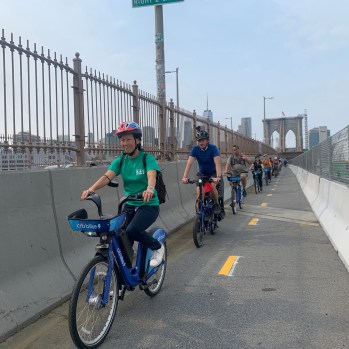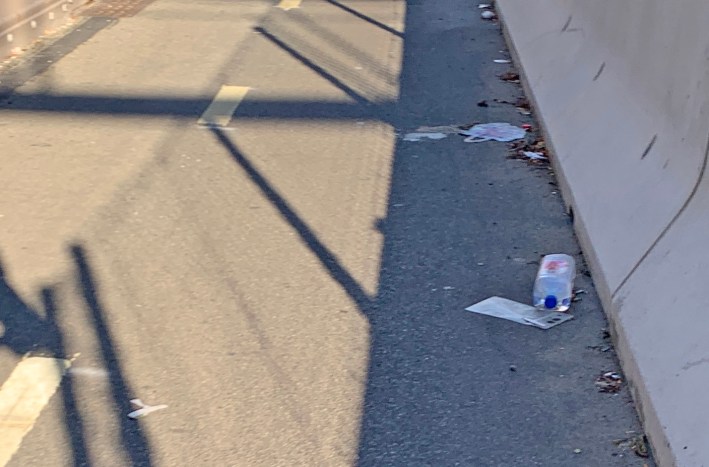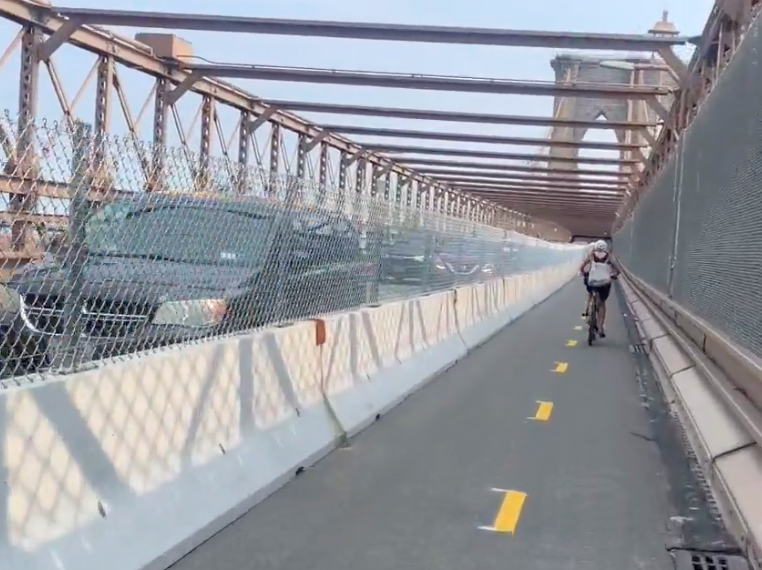
Here’s yet another lesson in induced demand.
Cycling is skyrocketing on the Brooklyn Bridge since the city built a new bike-only path on the historically dangerously overcrowded span, with the number of trips up 88 percent this October compared to the same time last year, the Department of Transportation said on Monday.
The new eight-foot two-way bike path on the roadbed of the bridge’s Manhattan-bound side — which was repurposed from a lane of car traffic — opened on Sept. 14. And from that day forward, average daily use of the path has jumped: This September, there were were 3,635 average daily trips, up from 2,336 last year — a 56 percent increase. The average daily rides in September were up almost 37 percent from 2019, the pre-pandemic era.
October numbers were even more impressive, with the number of average daily trips reaching a whopping 4,206 — up from 2,239, or 88 percent, in 2020, and up from 2,492, or close to 69 percent, in 2019. (See chart below.)
Meanwhile, rides over the Manhattan bridge and other city-owned East River spans have remained on par with historical trends, according to DOT.
DOT Commissioner Hank Gutman said he was proud that his agency “reclaimed space from cars to make cycling over the Brooklyn Bridge safer and easier, while making the pedestrian experience better than ever.” He urged all New Yorkers to “try the new lane and embrace cycling as a sustainable and healthy way to get around our great city.” (Gutman himself used the new path on its opening day, using his personal e-bike.)
The ridership numbers are a major victory for cyclists that comes at no surprise to the advocates who fought for more space for cyclists on the bridge, as well as others.
“It’s no surprise that building a dedicated protected bike path has empowered more people to cycle over the Brooklyn Bridge. Prioritizing people over cars to build safe bike infrastructure works,” said Liz Denys, a leader of the Transportation Alternatives Bridges 4 People campaign. “Now is the time to build on this success and make Bridges 4 People a reality by improving the connections to the Brooklyn Bridge and converting roadways to protected bike lanes on more bridges across the city.”
Mayor de Blasio announced his plans to repurpose a car lane on the Brooklyn Bridge in his State of the City address in January, but he also mentioned converting a formerly pedestrian lane of the Queensboro Bridge from a lightly used car roadway back into space for walkers, allowing the existing shared bike and pedestrian path to be set aside solely for cyclists. But that work will only begin this year, DOT has said; it will be completed next year. Advocates are frustrated, as that bridge is heavily used by pedestrians and cyclists, and crashes are frequent. The Queensboro Bridge is leading the bike boom, statistics show, and Manhattan-bound cyclists from Queens have no other options besides the span that bears the borough’s name.
The new Brooklyn Bridge pathway is a clear success, though at eight-feet-wide, the two-way bike path does not meet national standards. According to the National Association of City Transportation Officials, the recommended width of a two-way bike path is 12 feet. Eight feet is considered the bare minimum. (De Blasio has said the city is looking into adding a protected bike path on the Brooklyn-bound side of the Brooklyn Bridge roadway, which would free up the existing lane for westbound-only bike trips.)
Also as Streetsblog has previously reported, the city has been slow to finish bike routes for cyclists exiting the bridge who want to go north or west upon entering Manhattan. The city finished installing a protected bike lane on Centre Street, but it only runs between Chambers and Worth streets — and cyclists are plunged into an abyss of double-parked cars in front of the courthouses and given no safe passage to existing protected bike lanes on Grand Street (eastbound) and Lafayette Street (northbound). And there’s no direct route for cyclists who want to go west from the bridge towards the popular Hudson River Greenway. Chambers Street would be the logical location, but the city is currently building such a path one block to the north on Reade Street, though it will require cyclists to make a second detour to get to the greenway.
The Brooklyn Bridge ridership numbers come just days after Streetsblog reported on the packed new Crescent Street bike lane, amid a citywide bike boom that took off last year during the Covid-19 pandemic and has shown no signs of slowing down. Evidence suggests that ridership will continue to increase on the new infrastructure (as long as the city can keep it clean from garbage, which the city promises to do).







